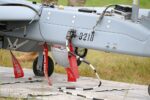At the Association of the United States Army (AUSA) 2025 Annual Meeting in Washington D.C., Oshkosh Defense unveiled its new Modular Mission Autonomous Vehicle (M-MAV) launcher variant—a highly mobile platform designed to fire rockets from the MLRS family of munitions while incorporating autonomous navigation and targeting capabilities. This development signals a potential leap in distributed fires and manned-unmanned teaming for U.S. and allied forces.
Modular Fires Platform Built on Proven JLTV Chassis
The new launcher variant is based on Oshkosh’s JLTV-derived Modular Mission Autonomous Vehicle (M-MAV), a platform originally developed for multi-role missions including logistics support, reconnaissance, and indirect fire support. The launcher module presented at AUSA 2025 transforms the M-MAV into a compact yet potent rocket artillery system capable of firing standard Guided Multiple Launch Rocket System (GMLRS) rounds and potentially other precision munitions.
Key features include:
- Compatibility with standard MLRS/HIMARS pod configurations
- Modular payload bay allowing rapid reconfiguration between roles
- Autonomous navigation via GPS/INS fusion and LIDAR-based obstacle avoidance
- Remote operation capability via secure C2 links
The launcher’s compact profile enables it to be air-transportable by C-130-class aircraft or sling-loaded under CH-47 helicopters—offering strategic mobility unmatched by heavier systems like HIMARS or tracked M270s.
A Complementary System to HIMARS in Distributed Fires Doctrine
The U.S. Army’s evolving doctrine emphasizes distributed operations and long-range precision fires across contested environments. In this context, the M-MAV launcher is not intended to replace HIMARS but rather augment it through greater dispersion and survivability.
Unlike traditional platforms requiring crewed deployment and static firing positions, the M-MAV can operate semi-independently across dispersed terrain. Its autonomy suite allows waypoint navigation under GPS-denied conditions using onboard sensors—a critical advantage in near-peer conflict scenarios involving electronic warfare (EW) threats.
This aligns with concepts such as “sensor-to-shooter” networks where autonomous or remotely controlled launchers can receive targeting data from ISR assets—including drones or satellites—and execute time-sensitive strikes without exposing personnel.
Weapon Integration: GMLRS Pods Today—Loitering Munitions Tomorrow?
The current configuration shown at AUSA supports one standard GMLRS pod (6 rockets), similar to those used by HIMARS. However, Oshkosh representatives hinted at future modularity enabling integration of alternative payloads such as:
- Loitering munitions / kamikaze drones for ISR-strike fusion
- Short-range air defense interceptors (e.g., AIM-9X derivatives)
- Anti-tank guided missiles (ATGM) swarms for area denial
This flexibility could allow commanders to tailor each vehicle’s loadout per mission—whether providing suppressive fires during an armored advance or executing counter-drone roles in layered SHORAD architectures.
C4ISR Integration and Remote Fire Control
A key enabler behind the M-MAV’s operational concept is its integration into modern command-and-control networks. The system supports Link-16 and other tactical data links for real-time coordination with joint fires cells. It can receive fire missions from remote operators or AI-assisted battlefield management systems.
The remote fire control capability reduces operator exposure while enabling faster kill chains. Operators can command multiple dispersed launchers from a single control node—potentially even from another vehicle or command post tens of kilometers away.
Autonomy Stack Developed Through DARPA-Aligned Programs
The autonomy suite embedded in the M-MAV builds upon previous work under DARPA’s Squad X and Ground X-Vehicle Technologies programs. It includes:
- Semi-autonomous route planning based on terrain analysis
- LIDAR + EO/IR sensor fusion for obstacle avoidance
- Redundant comms paths including SATCOM fallback modes
This enables “launch-and-leave” operations where vehicles autonomously reposition after firing to avoid counter-battery detection—a tactic increasingly vital against adversaries employing counter-fire radars and loitering munitions.
Strategic Implications for Allied Forces and Export Potential
The emergence of an air-mobile, modular rocket artillery system has implications beyond U.S. forces. NATO allies operating HIMARS-compatible munitions could adopt the M-MAV launcher as a cost-effective supplement to heavier systems—especially in expeditionary contexts like Eastern Europe or Indo-Pacific littorals where mobility is paramount.
Oshkosh has not yet confirmed export customers but noted that interest exists among several European nations seeking mobile fires solutions that align with NATO interoperability standards. The use of existing GMLRS stockpiles further enhances logistical compatibility without requiring new supply chains.
AUSA Debut Marks Beginning of Field Trials Phase
The prototype displayed at AUSA will enter limited field trials with U.S. Army units under the Rapid Capabilities Office starting Q1 2026. These trials will assess operational viability under live-fire conditions as well as software reliability in GPS-contested environments.
If successful, low-rate initial production could begin by late FY2027 under an Other Transaction Authority (OTA) contracting mechanism aimed at accelerating fielding timelines compared to traditional acquisition pathways.
Conclusion: A New Era for Modular Uncrewed Rocket Artillery?
The Oshkosh M-MAV launcher represents a convergence of autonomy, modularity, and proven firepower—all packaged into a tactically agile form factor suited for modern multidomain operations. While still early in development, its potential to reshape how rocket artillery is deployed—especially in high-threat environments—is significant.










